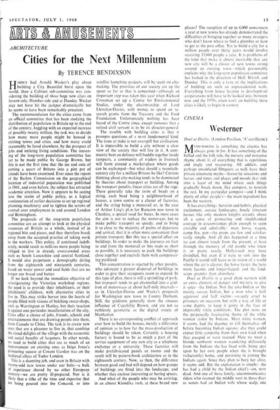Westerner
CINEMA Duel at Diablo. (London Pavilion, 'A' certificate.)
It has everything: heroism and hubris, physical excitement, outsize landscapes, lonely itinerant heroes (the only modern knights errant), above all a sense of pioneering and singlehanded courage in circumstances plain enough to seem enviable and admirable : man, horse, wagon, camp fire, gun—the props are few and satisfac- torily simple. And all this happened at a time we can almost touch from the present, at least through the memory of old people who knew it, or pretty nearly. Hollywood may have dwindled, but even if it were to sink into the Pacific it would still leave us its vision of a world where the air is clearer, the horse faster, the hero more laconic and longer-legged, and the land- scape grander than elsewhere.
Duel at Diablo is a good plain western with an extra element of danger and mystery to give it spice—the Indian. Not the joke-Indian or the merely savage Indian, but a man who is half aggressor and half victim—savagely cruel to prisoners on occasion, but with a way of life of some dignity to keep it going in the face of impossible white conditions. The plot turns on the perpetually fascinating theme of the white woman stolen by Indians. Most white women, it seems, had the decency to kill themselves off before becoming Indian squaws: else they could expect little sympathy from their own kind when they escaped or were rescued. Here we meet a blonde sunburnt woman wandering deliriously from the Indians she has lived with, being spat upon by her own people when she is brought (reluctantly) home, and persisting in joining the Indians again. Since they plan to bury her alive, it seems odd. But the explanation is simple: she has had a child by the Indian chief's son, now dead. And one of those lonely, uncommunicative riders who roamed the middle west in those days as scouts had an Indian wife whose scalp, one
evening, is handed to him. His revenge, and the woman's rescue, run parallel: both have accepted the outcast life that living with Indians entails.
To complicate things racially, there is a second hero, a Negro. This is Sidney Poitier, stylishly dressed in satin waistcoats as a result of some trading of half-broken horses to the army. Since in the final showdown with the Indians he's the only one who knows their kind of fighting, he ends up in charge. Of course he wins; but nearly everyone's dead before he does. The fighting in westerns grows fiercer and more credible as the realism of detail increases: the plunk of arrow in flesh, say. is not everyone's idea of entertain- ment, but the cruelty is all part of the myth, an element of the courage needed. I like Duel at Diablo as I like most westerns, and a good deal more than most. To call it childish is just to question the values of a world that is shown us as simple, tough, adventurous and physically harsh. Whether or not it existed as we are shown it, it comes across stirringly, making one marvel at the incredible hardships in an age where physical delicacy was so much valued : the women in all those petticoats on the one hand, the threat of burial alive on the other.
ISABEL QUIGLY































 Previous page
Previous page